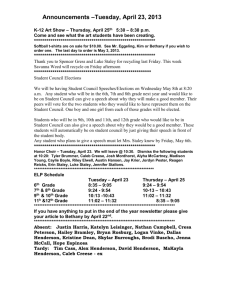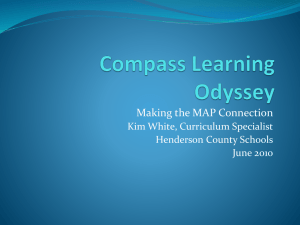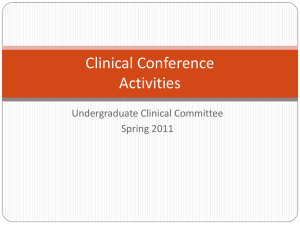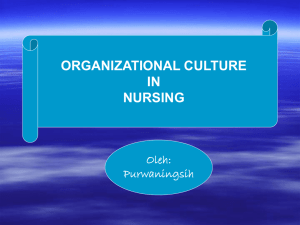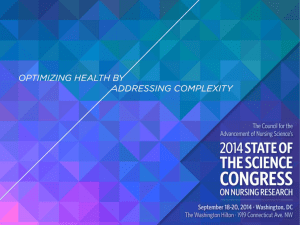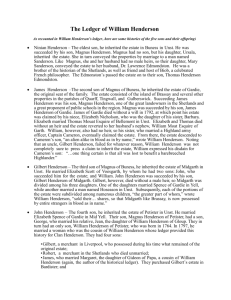Nursing Theorist: Virginia Henderson
advertisement
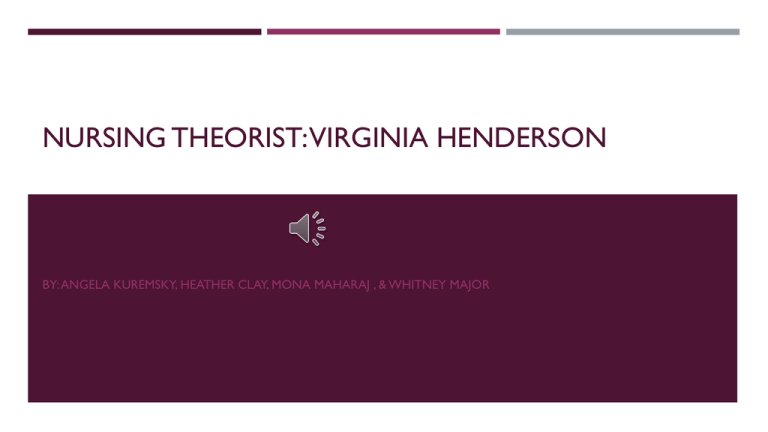
NURSING THEORIST: VIRGINIA HENDERSON BY: ANGELA KUREMSKY, HEATHER CLAY, MONA MAHARAJ , & WHITNEY MAJOR 1897-1996 HISTORY OF VIRGINIA HENDERSON Virginia Henderson was born November 30, 1897, in Kansas City, Missouri. In 1901, she and her family relocated to Virginia. Her first teaching position was at Teachers College, Columbia University in 1934. In 1939, her revision of Bertha Harmer’s Textbook of the Principles and Practice of Nursing was published. Virginia Henderson directed the Nursing Index Studies Project from 1959-1971, which led to her publication of the four volume Nursing Index Studies. Henderson was named research associate emeritus at Yale at age 75. Virginia Henderson for 70 years made remarkable contributions to nursing. She paid as an advocate for humane and holistic care for patients, promoter for nursing research, and author to widely used nursing texts. Henderson died March 19, 1996.4 WHY DID SHE DEVELOP THIS THEORY? Two events influenced the development of her definition of nursing and her theory. 2 1. Her participation in the revision of “The Textbook of the Principles and Practice of Nursing” written by Bertha Harmer. Following this, Henderson realized the need to be very clear about the role and functions of the nurse. 2 2. She grew concerned that many states had no provisions for nursing licensure. She felt it was important to establish the idea of what truly makes a nurse in order to ensure safe and competent care for patients. She examined the earlier statements of nursing functions set forth by the American Nurses Association and viewed these statements as non specific, unclear, and unsatisfactory. 2 NEED THEORY Virginia Henderson’s goal was not to develop a theory in nursing, but a unique focus on the nursing concept.2 Need Theory suggests that nurses should be caring for the patient, but at the same time helping the patient gain independence so that once they are discharged they are able to take care of themselves.2 The four major concepts addressed in this theory are: 1. The Individual2 2. The Environment2 3. Health2 4. Nursing2 This theory presents the patient as a sum of parts with biophysical needs rather than as a type of client or consumer. 2 THERE ARE FOURTEEN COMPONENTS BASED ON HUMAN NEEDS THAT MAKE UP NURSING ACTIVITIES. THESE COMPONENTS ARE: 1.Breathe normally. 2 9.Avoid dangers in the environment and avoid injuring 2. Eat and drink adequately.2 others.2 3.Eliminate body wastes.2 4.Move and maintain desirable postures.2 10.Communicate with others in expressing emotions, needs, fears, or opinions.2 5.Sleep and rest.2 11.Worship according to one's faith.2 6.Select suitable clothing. That is, dress and undress 12.Work in such a way that there is a sense of 7.Maintain body temperature within normal range by 13.Play or participate in various forms of recreation.2 appropriately.2 adjusting clothing and modifying the environment.2 8.Keep the body clean and well groomed and protect the integument.2 accomplishment.2 14.Learn, discover, or satisfy the curiosity that leads to normal development and health and use the available health facilities.2 HOW IT APPLIES… Henderson described the nurse's role as substitutive (doing for the person), supplementary (helping the person), or complementary (working with the person), with the goal of helping the person become as independent as possible. Henderson wanted to work to rehabilitate patients in order to make them more independent for themselves.5 Nurses need to stress promotion of health and prevention and cure of disease.5 Each nurse would want the 14 concepts for themselves and should strive for their patients to heal in the same environment.5 ACCOMPLISHMENTS Nursing Studies Index – First annotated index of nursing research.2 Sigma Theta Tau International Library – Named in honor of Virginia Henderson.2 The Virginia Henderson Award – Award created in her honor for outstanding contributions to nursing research.2 Received the first Christianne Reimann Prize for the transitional scope of her work. 2 Received honorary doctorate degrees from several universities. 2 SUMMARY Click to view a video summary of Henderson's life. CONCLUSION The 14 components that Henderson has adopted are ideas that all able bodied people should desire to have for themselves. Basic human needs are self-explanatory and uncomplicated. Henderson’s practice and concepts of nursing match how she defines nursing. Henderson has proven to be an important part of how nursing care should be provided; a sort of team-like approach and not just a nurse doing for a patient but assisting them into full rehabilitation. Care may be different today if her principles had not been adopted into current practice. REFERENCES 1Clark, J. (1997). The unique function of the nurse. International Nursing Review, 44(5), 144-152. http://eds.b.ebscohost.com/ehost/pdfviewer/pdfviewer?sid=033cef4b-209f-4b7d-b308-abd04c893cf7%40sessionmgr112&vid=7&hid=120 2Nursing Theory. (2013).Virginia 3Virginia 4Virginia A. Henderson 5Virginia 6Virginia 7Virginia theory.php Henderson. Retrieved from: http://www.nursing-theory.org/theories-and-models/henderson-need- Henderson - Nursing Need Theory - Nurseslabs. (n.d.). Retrieved October 5, 2014, from http://nurseslabs.com/virginiahendersons-need-theory/ (1897-1996) 1996 Inductee. (n.d.). Retrieved September 29, 2014, from http://www.nursingworld.org/VirginiaAHenderson. Henderson's Need Theory. (n.d.). Retrieved October 1, 2014, from http://currentnursing.com/nursing_theory/Henderson.html. Henderson’s Nursing Need Theory. (2014, August 6). Retrieved October 3, 2014, from http://nurseslabs.com/virginiahendersons-need-theory/ Henderson. (1966, January 1). Retrieved October 5, 2014, from http://izquotes.com/quote/236610
